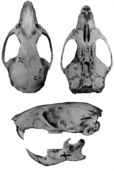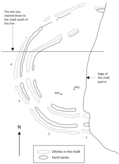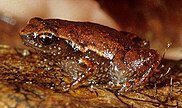Wikipedia:Today's featured article/October 2022
| << | Today's featured articles for October 2022 | >> | ||||
|---|---|---|---|---|---|---|
| Su | Mo | Tu | We | Th | Fr | Sa |
| 1 | ||||||
| 2 | 3 | 4 | 5 | 6 | 7 | 8 |
| 9 | 10 | 11 | 12 | 13 | 14 | 15 |
| 16 | 17 | 18 | 19 | 20 | 21 | 22 |
| 23 | 24 | 25 | 26 | 27 | 28 | 29 |
| 30 | 31 | |||||
October 1
Momčilo Đujić (1907–1999) was a Serbian Orthodox priest and warlord who led a force of Chetniks within the Independent State of Croatia, a fascist and Axis puppet state in Yugoslavia during World War II. Đujić was ordained as a priest in 1933 and was active in promoting workers' rights. After Axis forces invaded Yugoslavia in April 1941, he led a group of Chetniks in defending local Serbs from the ruling Ustaše. He then collaborated with the Italians, subverting Communist-led Partisan units, and attacking them alongside the Italians. He formed the Chetnik Dinara Division in early 1942. On 1 October 1942, Chetniks under Đujić's command massacred nearly 100 Croats in the village of Gata. After the war Đujić was tried and convicted in absentia of multiple war crimes by the new Yugoslav communist government, and was accused of being responsible for 1,500 deaths. He emigrated to the United States, where he died aged 92. (Full article...)
October 2
Hurricane Sergio was a powerful and long-lived tropical cyclone that hit the Baja California Peninsula as a tropical storm and caused flooding throughout southern Texas in early October 2018. Sergio became the eighth Category 4 hurricane in the East Pacific for 2018, breaking the record of seven set in the 2015 season. The twentieth named storm, eleventh hurricane, and ninth major hurricane of the season, Sergio organized into a tropical storm on September 29 and became a hurricane on October 2. It peaked as a Category 4 hurricane on October 4, with reported maximum sustained winds of 140 mph (220 km/h). It maintained peak intensity for 12 hours before weakening. The system then began another period of intensification, achieving a secondary peak with reported winds of 125 mph (205 km/h) on October 6. It made landfall in western Baja California Sur on October 12, caused over US$2 million in damage, and triggered over a thousand school closures. (This article is part of a featured topic: 2018 Pacific hurricane season.)
October 3
Operation Hurricane was the first test of a British atomic device, detonated on 3 October 1952 in the lagoon in the Montebello Islands in Western Australia. During the Second World War, Britain commenced a nuclear weapons project, known as Tube Alloys, but the 1943 Quebec Agreement merged it with the American Manhattan Project. Several key British scientists worked on the Manhattan Project, but after the war the Americans ended cooperation. In January 1947, a cabinet sub-committee decided to resume efforts to build nuclear weapons. To test the effects of a ship-smuggled atomic bomb on a port (a threat of concern to the British at the time), the bomb was exploded inside the hull of a frigate, HMS Plym, leaving a saucer-shaped crater on the seabed 6 metres (20 ft) deep and 300 metres (1000 ft) across. With the success of Operation Hurricane, Britain became the third nuclear power, after the United States and the Soviet Union. (This article is part of a featured topic: Nuclear weapons and the United Kingdom.)
October 4

The banded broadbill (Eurylaimus javanicus) is a species of typical broadbill found in Mainland Southeast Asia and the Greater Sunda Islands. It inhabits a variety of forests, mostly in lowland areas. A striking, large-bodied bird, it is mostly purplish-red, with yellow-streaked black wings, a bright blue beak, a blackish face, and greyish chin and upper breast. Females can usually be told apart from males by their lack of a neckband. The species mainly eats arthropods, but also feeds on snails, lizards, frogs, and figs. Breeding occurs during the dry season on the mainland, from March to November in the Greater Sundas, and year-round on Java. Nests are built over clearings or water bodies and have clutches of two or three eggs. The banded broadbill is sometimes split into two species, E. javanicus and E. harterti, including by the International Union for Conservation of Nature, which classifies E. javanicus as being near-threatened and E. harterti as being of least concern. (Full article...)
October 5

Rachel Dyer is a Gothic novel of historical fiction by American writer John Neal (depicted). Published in 1828 in Maine, it is the first bound novel about the Salem witch trials. It garnered little critical notice in its day but influenced works by better-known authors. It is best remembered for "Unpublished Preface", an American literary nationalist essay that precedes the story. Following a darkly poetic narrative, the story centers around historical figure George Burroughs and fictional witch hysteria victim Rachel Dyer. About two-thirds of the story takes place in the courtroom, following the trials of alleged witches. Themes include justice, sexual frustration, mistreatment of American Indians by Puritans, the myth of national American unity in the face of pluralist reality, and republican ideals as an antidote for Old World precedent. The novel experiments with speech patterns, dialogue, and transcriptions of Yankee dialect that Neal hoped would come to characterize American literature. (Full article...)
October 6
The Chicxulub crater is an impact crater buried underneath the Mexican Yucatán Peninsula, with its center located offshore, near the town of Chicxulub. The crater is about 180 kilometers (110 mi) in diameter, making it one of the largest confirmed impact structures in the world; the asteroid whose impact (animation shown) formed the crater was at least 10 km (6 mi) in diameter. Discovered by geophysicists looking for petroleum in the late 1970s, the impact structure was formed around 66 million years ago near the end of the Cretaceous period. It is widely accepted that the devastation and climate disruption from the impact was the cause of the Cretaceous–Paleogene extinction event, in which around 75 percent of all plant and animal species on Earth became extinct, including all non-avian dinosaurs. A 2021 study stated that the impactor likely originated in the outer main part of the asteroid belt. (Full article...)
October 7
From the late 19th century until 1933, the first homosexual movement unsuccessfully sought the repeal of Paragraph 175, a German law criminalizing sex between men. In 1897, Magnus Hirschfeld founded the Scientific-Humanitarian Committee—the world's first homosexual rights organization—to achieve this goal through science. The movement greatly expanded after World War I and the German revolution, when the first mass-market periodicals for gay people were published. The German Friendship Society and the League for Human Rights, founded after the war, emphasized human rights and respectability politics. In 1929, the German parliament considered but ultimately did not vote on a proposal to decriminalize homosexuality. The movement waned after failing to achieve its objectives, and was shut down after the Nazi takeover in early 1933. The first homosexual movement has inspired and influenced later LGBT movements. (Full article...)
October 8
The Alexander Hamilton U.S. Custom House is located at 1 Bowling Green, near the southern end of Manhattan. Named for Alexander Hamilton, a Founding Father, and designed by Cass Gilbert in the Beaux-Arts style, it was erected from 1902 to 1907 to house the Port of New York's duty-collection operations. The building contains the George Gustav Heye Center museum, the United States Bankruptcy Court for the Southern District of New York, and local offices of the National Archives. The facade and part of the interior are New York City designated landmarks, and the building is a National Historic Landmark listed on the National Register of Historic Places. The main entrance consists of a grand staircase flanked by Four Continents, a set of four statues by Daniel Chester French. The United States Customs Service moved out of the building in 1974, and it remained vacant for more than a decade until renovations in the late 1980s. (Full article...)
October 9
Daglish railway station is a commuter railway station on the boundary of Daglish and Subiaco, suburbs of Perth, Western Australia. Opened on 14 July 1924, the station was named after Henry Daglish, who was a mayor of Subiaco, a member for the electoral district of Subiaco, and a premier of Western Australia in the 1900s. The station consists of an island platform accessed by a pedestrian underpass. Daglish station is on the Fremantle line, and starting on 10 October 2022, the Airport line, which are both part of the Transperth network. Fremantle line services run every 10 minutes during peak hour and every 15 minutes outside peak hour and on weekends and public holidays. Upon the Airport line's opening, Fremantle line and Airport line services will run every 12 minutes during peak hour, for a combined frequency of a train every 6 minutes. The journey to Perth station is 4.9 kilometres (3.0 mi) long and takes 7 minutes. (Full article...)
October 10
The Fort Vancouver Centennial half dollar is a commemorative fifty-cent piece struck by the United States Bureau of the Mint in 1925 in honor of the founding of Fort Vancouver in present-day Vancouver, Washington. The obverse of the commemorative coin (pictured) depicts John McLoughlin, who built the fort for the Hudson's Bay Company in 1825. The reverse shows an armed frontiersman standing in front of the fort. Representative Albert Johnson of Washington state was able to get Congress to authorize a coin for Fort Vancouver's centennial celebrations, and President Calvin Coolidge signed the authorizing act on February 24, 1925. Laura Gardin Fraser was engaged to design the coin on the recommendation of the United States Commission of Fine Arts. The coins were struck at the San Francisco Mint, and then were flown to Washington state by airplane as a publicity stunt. They sold badly, and are valuable today since few of the coins survive. (Full article...)
October 11

"Delicate" is an electropop song by American singer-songwriter Taylor Swift (pictured), taken from her sixth studio album, Reputation (2017), and released as a single in March 2018. It was written by Swift and its producers, Max Martin and Shellback. The lyrics are about insecurity with a new love interest. To create a sound accompanying the vulnerable sentiment, Martin and Shellback manipulated Swift's vocals with a vocoder. "Delicate" is a ballad with dense synthesizers and house beats. In the music video, Swift dances barefoot through public places, dripping wet from the rain and invisible to others. Music critics praised Swift's songwriting and the mellower production compared to the album's overarching brash sound. The song featured in 2018 year-end lists by Billboard, Slant Magazine, and Rolling Stone. A sleeper hit in the U.S., "Delicate" peaked at number 12 on the Billboard Hot 100 and topped Billboard's airplay charts: Mainstream Top 40, Adult Contemporary, and Adult Pop Songs. (Full article...)
October 12

Operation Sandwedge was a proposed surveillance campaign that would have targeted people that U.S. president Richard Nixon considered his political enemies. The operation, intended to help Nixon's re-election campaign in the 1972 election, would have used illegal black bag operations to get information on the financial status and sexual activities of Nixon's opponents. It was also designed to target the Democratic Party and the movement opposed to the Vietnam War, as well as rivals within Nixon's own Republican Party. The proposals were put together in 1971 by Chief of Staff H. R. Haldeman, domestic affairs assistant John Ehrlichman (both pictured), and Jack Caulfield, a staffer. Control of the operation was passed to G. Gordon Liddy, who abandoned it in favor of a strategy of his own, Operation Gemstone, which included a plan to break into Democratic Party offices in the Watergate complex. Liddy's plan eventually led to the downfall of Nixon's presidency. (Full article...)
October 13
Adiantum viridimontanum, the Green Mountain maidenhair fern, is a rare fern found in outcrops of serpentine rock in New England and Quebec. It is named after the site of its discovery in the Green Mountains in Vermont. Until 1991, it was grouped with the western maidenhair fern A. aleuticum, which itself was classified as a variety of the northern maidenhair fern A. pedatum. A. viridimontanum is a hybrid species and the other two ferns are distinct species, although it is difficult to distinguish between the three in the field. Due to the limited distribution of A. viridimontanum and its similarity to other species, little is known of its ecology. It thrives on sunny, disturbed areas where ultramafic rock is covered with thin soil, such as roadcuts, talus slopes, and asbestos mines. Individual plants seem long-lived, and new ones only infrequently reach maturity. One of four species endemic to serpentine in eastern North America, it is considered vulnerable due to its habitat restrictions. (Full article...)
October 14
The Sayfo, or Assyrian genocide, was the mass slaughter and deportation of Assyrian and Syriac Christians in southeastern Anatolia and Persia's Azerbaijan province committed by Ottoman forces and Kurdish tribes during World War I. The Assyrians lived in mountainous and remote areas and were divided into several mutually antagonistic churches. Mass killing of Assyrian civilians began in January 1915, by the Ottoman military and pro-Ottoman Kurds. Attacks on, massacres of and deportations of Christian populations continued until 1919, usually facing only sporadic armed resistance. Ottoman Assyrians living in present-day Iraq and Syria were not targeted. The Sayfo occurred concurrently with and was closely related to the Armenian genocide. Motives included a perceived lack of loyalty among some Assyrian communities to the Ottoman Empire and a desire to appropriate their land. In 1919 the Assyrians said that roughly 250,000 were killed in the genocide, about half the pre-war population. (Full article...)
October 15
The Second Punic War (218–201 BC) was the second of three wars fought between Carthage and Rome, the two main powers of the western Mediterranean in the 3rd century BC. For 17 years the two states struggled for supremacy. After immense materiel and human losses on both sides the Carthaginians were defeated. Macedonia, Syracuse and several Numidian kingdoms were drawn into the fighting, and Iberian and Gallic forces fought on both sides. There were three main military theatres during the war: Italy, where Hannibal defeated the Roman legions repeatedly, with occasional subsidiary campaigns on the islands of Sicily and Sardinia and in Greece; Iberia, where Hasdrubal, a younger brother of Hannibal, defended the Carthaginian colonial cities with mixed success before moving into Italy; and North Africa, where Rome finally won the war. A peace treaty stripped the Carthaginians of all overseas territories, and prohibited them from waging war outside Africa. (This article is part of a featured topic: Punic Wars.)
October 16

The Borodino-class battlecruisers were a group of four battlecruisers ordered by the Imperial Russian Navy before World War I for service with the Baltic Fleet. Construction of the ships was delayed by a lack of capacity among domestic factories and the need to order some components from abroad. The start of the war in 1914 slowed their construction still further. All of the ships were launched in 1915–1916, but it became evident that Russian industry would not be able to complete them during the war. The Russian Revolution of 1917 halted all work on the ships. Although some consideration was given to finishing the hulls that were nearest to completion, they were all eventually sold for scrap by the Soviet Union. The Soviet Navy proposed to convert Izmail (pictured), the ship closest to completion, to an aircraft carrier in 1925, but the plan was cancelled after political manoeuvring by the Red Army led to funding not being available. (This article is part of a featured topic: Battlecruisers of the world.)
October 17

Megalograptus is a genus of eurypterid, an extinct group of aquatic arthropods containing five species, all based on fossil material found in the United States: M. alveolatus, M. ohioensis (pictured), M. shideleri, M. welchi and M. williamsae. They were predators, with the largest and best-known species, M. ohioensis, growing to 78 centimeters (2 ft 7 in). The two most distinctive features of Megalograptus were its massive and spined forward-facing appendages, and its sharp spike-shaped telson (the last division of the body). Attached beneath the non-venomous telson were a pair of rounded blade-formed lobes which made it capable of grasping. Researchers have been able to infer the coloration that specimens might have possessed in life, believed to be brown and black, with M. ohioensis being darker than the others. Megalograptus lived in near-shore marine environments, where it used its large appendages to capture prey. The predator may have been cannibalistic at times, like many modern chelicerates. (Full article...)
October 18
Offham Hill is a Neolithic archaeological site and scheduled monument near Lewes, East Sussex. It was first identified as a possible causewayed enclosure in 1964; like others in England, it was enclosed with ditches interrupted by gaps, or causeways. Such enclosures may have been settlements, meeting places, or ritual sites. Offham Hill was inspected by the Ordnance Survey in 1972 and excavated by Peter Drewett in 1976. By this time, it had been badly damaged by ploughing and partially obliterated by a chalk quarry. Most finds came from the ditches, including about 7,000 worked flints, nearly 300 sherds of pottery, a human burial, other human bones, and animal remains. The site and most of the pottery were identified as Neolithic, in part by radiocarbon dating. Further ploughing after the 1976 excavation led to the effective destruction of the site. A reanalysis of the site's artefacts and human remains in 2011 confirmed a construction date in the mid-fourth millennium BC. (Full article...)
October 19
Yusuf I (29 June 1318 – 19 October 1354) was the seventh Nasrid ruler of the Emirate of Granada on the Iberian Peninsula, from 1333 until his death. He allied with the North African Marinids against Alfonso XI of Castile. After a naval victory in April 1340, the Marinid–Granadan alliance was decisively defeated in the Battle of Río Salado (depicted). In 1342–1344, Alfonso besieged and captured the port of Algeciras. A ten-year peace treaty followed, but Alfonso broke it and besieged Gibraltar in 1349. The siege ended when Alfonso died of the Black Death in March 1350. Yusuf signed a treaty with Alfonso's son and successor Peter I. Yusuf was assassinated by a madman while praying in the Great Mosque of Granada. During his reign, the emirate flourished in the fields of literature, medicine, and law. Yusuf was responsible for many new buildings, and major cultural figures served in his court. Modern historians consider his reign and that of his son Muhammad V as the golden era of the Emirate. (Full article...)
October 20
Amador Valley High School is a public school in Pleasanton, California, a city east of San Francisco. Amador Valley is one of three high schools in the Pleasanton Unified School District, which includes Foothill High School and Village High School. The school was founded as Amador Valley Joint Union High School and opened in 1922. Major construction and renovations were undertaken after district voters approved bonds in 1922, 1965, 1997, and 2016. The school has been named a California Distinguished School and a National Blue Ribbon School. Amador Valley offers its students Advanced Placement courses, varsity sports, vocational training, and a variety of extracurricular activities. The school placed second in RoboSub, an international robotics competition, and first in We the People, a national civics competition, in 2022. The Amador Theater, one of Pleasanton's performing arts facilities, has been hosted at the high school since 1932. (Full article...)
October 21
"Streets" is a song by American rapper and singer Doja Cat (pictured). Appearing on her second studio album Hot Pink (2019), it is an R&B ballad with lyrics about a desire to return to a former romantic partner. The song became a sleeper hit around 15 months after the album's release—specifically, it went viral on the video-sharing application TikTok. It appeared in over 300,000 TikTok videos as background music for the "Silhouette Challenge", an online challenge in which participants danced while illuminated from behind with red lighting. Driven primarily by streams and digital sales, the song peaked within the top 20 of many national record charts, including the US Billboard Hot 100, and received platinum certifications in eight countries. "Streets" was sent to US contemporary hit radio stations as Hot Pink's seventh and final single on February 16, 2021. A corresponding music video premiered the next month, depicting Doja Cat's own version of the Silhouette Challenge. (Full article...)
October 22
The Weardale campaign occurred during July and August 1327. In 1326, while England was at war with Scotland, the English king Edward II was deposed by his wife, Isabella, and her lover, Roger Mortimer. Seeing opposition to the Scots as a way of legitimising their position, Isabella and Mortimer prepared a large army to oppose them, accompanied by the newly crowned Edward III. After two weeks of poor supplies and bad weather the English confronted the Scots when the latter deliberately gave away their position. The Scots occupied unassailable positions and the English declined to attack them. A Scottish force raided the English camp, penetrating as far as the royal pavilion. The English believed that they were starving out the surrounded Scots, but on the night of 6 August the Scots escaped and marched back to Scotland. The campaign was ruinously expensive for the English. Isabella and Mortimer were forced to negotiate, and in 1328 a peace treaty recognising Scottish sovereignty was signed. (Full article...)
October 23
Ich will den Kreuzstab gerne tragen (lit. 'I will gladly carry the cross-staff'), BWV 56, is a solo cantata for a bass singer by Johann Sebastian Bach. First performed in Leipzig on 27 October 1726, the 19th Sunday after Trinity, it was scored for woodwinds, strings and continuo, and features an obbligato oboe. The autograph score (pictured) is one of a few cases where Bach described one of his compositions as a cantata. In 2015 it was discovered that Bach collaborated with mathematics and theology student Christoph Birkmann, who wrote the text about a Christian willing to "carry the cross" as a follower of Jesus, in a life compared to a voyage towards a harbour. The work's five movements include arias, recitatives and the chorale "Komm, o Tod, du Schlafes Bruder" ('Come, o death, you brother of sleep'). In his Bach biography, Albert Schweitzer said it placed "unparalleled demands on the dramatic imagination of the singer". It has been recorded more than 100 times since a 1939 live broadcast. (Full article...)
October 24

Oryzomys antillarum, the Jamaican rice rat, is an extinct rodent known from subfossils and specimens collected live in the 19th century. It probably became extinct late in that century, perhaps due to the introduction of the small Indian mongoose, competition with introduced rodents such as the brown rat, and habitat destruction in Jamaica. O. antillarum was a medium-sized rat, with a length of 120 to 132 mm (4.7 to 5.2 in), not including the tail; the skull was about 30 mm (1.2 in) long. The upperparts were reddish and graded into the yellowish underparts. The tail was about as long as the head and body, sparsely haired, and darker above than below. The species was similar in most respects to the rice rat Oryzomys couesi of mainland Central America, but had longer nasal bones, shorter perforations of the palate near the incisors, and more robust cheekbones. (This article is part of a featured topic: Oryzomys.)
October 25
The second battle of Cape Finisterre was a naval encounter fought on 25 October 1747 during the War of the Austrian Succession. A British fleet of fourteen ships of the line commanded by Rear-Admiral Edward Hawke (depicted) intercepted a French convoy of 250 merchant ships protected by eight ships of the line commanded by Vice Admiral Henri-François des Herbiers. When the two forces sighted each other, Herbiers attempted to draw the British warships towards him. In this he was successful and the British enveloped the rear of the French line and brought superior numbers to bear on the French vessels one at a time. Six of the French warships were captured, along with 4,000 of their seamen. Of the 250 merchant ships, only 7 were captured. The British victory isolated the French colonies from supply and reinforcement. The war ended the following year and France recovered its colonial losses in return for withdrawing from its gains in the Austrian Netherlands. (Full article...)
October 26

Mischief Makers is a 1997 side-scrolling platform video game, the first for the Nintendo 64 (pictured), developed by Treasure and published by Enix and Nintendo. The player assumes the role of Marina, a robot who grabs, shakes, and throws objects in her journey to rescue her creator from the planet's emperor. The game is presented in 2.5D, with pre-rendered 3D backgrounds behind 2D gameplay. A 12-person team developed the game over two years as Treasure's first title for a Nintendo console. It was shown at the 1997 Electronic Entertainment Expo before its release. Reviews were mixed, with praise for its inventiveness, personality, and boss fights, but criticism for its brevity, low difficulty, low replay value, sound, and harsh introductory learning curve. Retrospective reviewers disagreed with the originally poor reception, and several highlighted Marina's signature "Shake, shake!" sound bite. In 2009, GamesRadar called it "possibly the most underrated and widely ignored game on the N64". (Full article...)
October 27
Mini scule is a species of microhylid frog endemic to Madagascar that was described in 2019. The scientific name of the species refers to its size, being a pun on the word minuscule. It is very small, measuring only 8.4 to 10.8 mm (0.33 to 0.43 in) in snout–vent length. It has bronze underparts with a brown groin and back of the thigh, cream upperparts with brown flecking, a dark brown side of the head, and a red iris. On the hind feet, the first toe is absent and the second and fifth toes are strongly reduced. The frog is known only from the Sainte Luce Reserve, where it inhabits areas with deep leaf litter near semi-permanent water bodies. Specimens of frogs from Mandena, the Vohimena mountains, the southern Anosy Mountains, and Tsitongambarika may also be of this species. Along with Mini mum and Mini ature, the other two species in its genus, it received media attention when first described due to the wordplay in its scientific name. (Full article...)
October 28
Head over Heels is an American television sitcom created by Jeff Franklin that aired on the United Paramount Network from August 26 to October 28, 1997. The series is set in a video dating agency based in Miami Beach, Florida, and run by brothers Jack (played by Peter Dobson) and Warren Baldwin (Mitchell Whitfield). Their employees are Valentina (Cindy Ambuehl) and two romance counselors, Carmen (Eva LaRue) and Ian (Patrick Bristow, pictured). Connie Stevens was initially cast, but never appeared in the show. Andrew Gottlieb was a co-producer, and Vince Cheung and Ben Montanio were consulting producers. The sitcom was the lowest-performing series tracked by Nielsen Holdings for the 1997–1998 television season. Head over Heels was one of 30 U.S. programs that season to feature a gay, lesbian, or bisexual character; Ian was bisexual. Critics faulted the show's characters, sex comedy, and lack of diversity. (Full article...)
October 29
The history of Burnley Football Club, an English professional association football club, includes an FA Cup win when they defeated Liverpool in the 1914 final, and two top-flight league titles: in the 1920–21 season after a 30-match unbeaten run, and in 1959–60 under manager Harry Potts, with a last-day victory over Manchester City. Founded on 18 May 1882 in Burnley, Lancashire, by Burnley Rovers rugby club members, Burnley F.C. were one of the twelve founder members of the Football League, in 1888–89. From the 1950s until the 1970s under chairman Bob Lord, the club became known for its youth policy and scouting system, and was one of the first to set up a purpose-built training ground. Frequently promoted and relegated, they prevented relegation to the highest level of non-League football on the last matchday in 1986–87. By winning the Fourth Division, in 1991–92, they became the second team to win all four professional divisions of English football. (This article is part of a featured topic: Burnley F.C.)
October 30
Philip I Philadelphus (between 124 and 109 – 83 or 75 BC) reigned as King of Syria, a ruler of the Seleucid Empire, in the early years of the 1st century BC when the country was torn apart by civil wars amongst Seleucid claimants. Seleucus VI, Philip's oldest brother, was killed during the war with their cousin Antiochus X in 94 BC. Philip declared himself king jointly with his twin Antiochus XI, and took the capital Antioch, where Antiochus XI took residence as the senior king, while Philip remained in a base in Cilicia. Antiochus X returned and killed Antiochus XI in 93 BC. Philip allied with another brother, Demetrius III, who ended up taking Antioch after Antiochus X's death, and besieged Philip, who allied himself with the Parthians and took the capital, becoming the senior king of Syria. Philip's death year is unknown, but probably before 75 BC. He was apparently considered the last legitimate king of Syria by the Romans, who continued to issue coins with Philip's portrait until 13 BC. (Full article...)
October 31
The pale crag martin (Ptyonoprogne obsoleta) is a bird in the swallow family that is resident in northern Africa and in southwestern Asia. It breeds in mountains, other rocky areas and towns. It is 12–13 cm (4.5–5 in) long, with mainly brown plumage, and paler below, with white "windows" on the tail that show as it hunts along cliffs for flying insects. It builds a deep bowl or quarter-sphere nest on a flat surface, vertical rock face or wall, made with mud and lined with grass or feathers. It is normally a solitary breeder, but small groups may sometimes nest close together. The two or three eggs of a typical clutch are white with brown and grey blotches, and are incubated by both adults for 16–19 days prior to hatching. Both parents then feed the chicks. Fledging takes another 22–24 days. With a large range and apparently increasing population, this species faces no major threats. It is assessed as a least-concern species on the IUCN Red List. (This article is part of a featured topic: Crag martins.)























